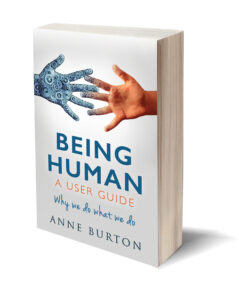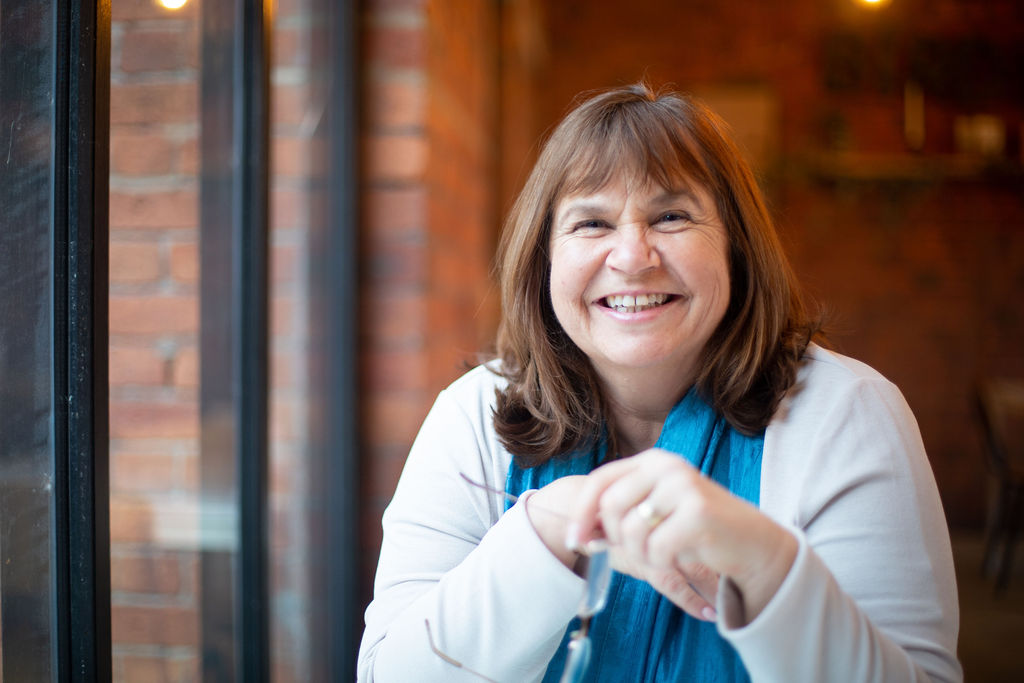Restore Balance
Working as an accountant in industry for over twenty years provided Anne Burton with many examples of how difficult people find it to manage the challenges of business change processes and a first-hand experience of the stress that can result from trying to achieve more and more with less and less. It also left her with a long-term fascination and passion for why people do what they do. In over a decade of study she began to notice that some important aspects of being human have been largely ignored and that these aspects of us need to be in balance if we are to experience our lives at their best and retain our true humanity. She brought her findings together in her first book, Being Human – A User Guide: Why we do what we do..
A Guide to Being Human
Why do we need a user guide to being human?
Being a human is just what we do so it might seem strange to suggest that we need a user guide. The problem is that for generations now we have been taught half a story about how we develop into mature adult human beings. We have been taking a mechanistic and academic approach to parenting that is missing some vital information, and it can result in many of us questioning why we do the things we do as adults. We can come to wonder if there is something wrong with us when we don’t think, feel and act the way we believe we should.
When I brought my children home from hospital after they were born more than thirty years ago, I was armed with advice and guidance about their physical care and what motor and language skills I should expect to see over time. When my son and his wife brought their first child home decades later, I noticed that nothing much had changed. We are taught how to support the physical and intellectual development of the next generation but not about the process of how they make sense of who they are, how they form beliefs and values and what impact this has on the experience they have of growing up.
It would be almost unthinkable to introduce and try to manage a new computer system without a good user guide and some training…and still we try to develop and care for the most complex computing power on the planet in an increasingly complex environment with little more than basic maintenance instructions.
The information we are missing answers the question of why two children can grow up in the same household with the same parents and yet have very different outlooks on life and beliefs about themselves. We have an amazing brain that can make connections, find patterns and create meaning at lightning speed. It can do all of this so quickly that we often don’t consciously know that the process has taken place. We can be present at the same event as someone else and the experience we have of it can be very different because, although the process of making meaning is the same for everyone, the meaning we make is individual to us.
These rapidly constructed patterns and meanings become the basis of programs that run on autopilot for everything we do. From cleaning our teeth to choosing a life partner, most of our behaviors, and therefore our results, are managed by processes that we have no understanding of. They happen so automatically that they can feel like they are just part of our make-up and outside of our control. When we have a user guide to explain how these processes work we can then choose, if we wish, to work with the way that these processes naturally function and make changes to meanings, beliefs and behaviors if the programs we are currently running are not supporting us well.
How do we increase our connection with others?
We can fly to the other side of the world in a day; we can speak to and see people anywhere at any time; we can instantly send messages via different media, and yet, we are more disconnected from each other than ever.
Dramatic though this may sound, connection is vital to our very existence as human beings. We can’t survive without it, and yet it has been undervalued for a long time in many parts of the world to the point where people are quite literally becoming ill and dying of loneliness. When we realize how important it is for us, there is fortunately a lot we can do to rebuild what we have lost.
When we are born, connection is as important as nourishment and parents feeding a baby tend to hold their child in the left arm while feeding because this creates the perfect positioning for left eye to left eye contact. This connects more directly with the right, more emotionally focused, part of our brain. It’s a vital part of our emotional development and sense of belonging. Without it our sense of ourselves and our place in the world can suffer. Knowing this means that we can begin to increase our level of connection with others quickly and simply by making eye contact more often. It doesn’t need to be a long meaningful gaze into someone else’s eyes (which can be a little too intense and create the opposite of the connection that you are seeking…so it’s probably not a good idea to start doing that on the bus ride home) even a moment of eye to eye connection can make a world of difference. So often these days we are too wrapped up in our own world or glued to our phones to notice many of the people we meet on a daily basis. We can interact with people in other ways, when we buy a coffee or pay for our shopping for example, and yet we don’t interact in the way that lets them know that we recognize them as another human being. This is, in effect, what even the briefest of eye contact does.
When we look someone in the eye the mirror neurons in our brain fire and we get a momentary hit of recognition. It’s like a mutual acknowledgement that we both exist and have value. It’s simple and powerful and can change someone’s day, and yours of course.
There are many other things we can do as well as increase the amount of eye contact we make that will, over time, increase our level of connection with others, and this is in itself an important point to note. We need to increase our connection over time. Even with someone you already know fairly well, an approach of “Hey let’s connect more” is unlikely to get you the sense of connection you really need or want. Starting to increase the number of face-to-face interactions in preference to virtual ones is a good place to start, as is actually listening to people when you do meet. We often don’t listen to understand and instead just wait for the other person to stop speaking so we can speak. So, really listening to what someone is saying to you is another very simple but effective way of increasing our connection with them.
The thing is, we need to slow down a little and consider how we are interacting with other people. There used to be a road safety campaign in the UK in the 1970’s that said ‘Stop, Look, Listen, Think’ and that’s what we need to do to start building on our connection to others, and not just when we cross the road.
How to Increase Your Courage
What are some ways to increase our courage?
One of the best things we can have to help us through a bit of a courage crisis is a good friend, and preferably one with a good sense of humor, because when our courage falters we often dive deep in to an imaginary world where everyone (including ourselves) is pointing and laughing. The reality is that not only are people not pointing and laughing, they are actually more on your side than you are, and there’s nothing like having this pointed out by a friend to help us gain a little perspective.
Of course, there isn’t always a friend on hand to help when we need a little more courage and there are things that we can do for ourselves, too:
Our courage is often challenged by our fear of failure, and it’s the meaning that we attach to failing that is the problem here. We have, for a long time now, had a very black and white view of success and failure. Either you do one of them or the other. If you fail, you’re done; it’s the end of the road for you. The truth is though that no one ever succeeded at anything without failing a few times first. We don’t learn to walk without falling over a few times, and thankfully small children haven’t learned to make the connection between falling and failing because they don’t let it stop them getting up and trying again.
If we learn to reclassify our less than successful endeavors as feedback or learning instead of failure, we can hold on more easily to the courage to keep getting up and starting again when things don’t work out. What can you learn for next time? What will you do differently? What are the good parts of what you did that you can build on?
Changing the language that we use can go a long way to reclassifying failure as feedback too. When we say ‘I can’t do it’ it sounds like a fact that will never change. When we change that to ‘I can’t do it yet,’ it implies that we are still moving forward and will be able to do it at some point in the future. And of course, when we do get the result that we wanted we need to celebrate it too, because downplaying our successes and minimizing our achievements can keep us feeling like a failure even in the face of some powerful evidence to the contrary. So, don’t shrug off positive feedback from others. Give yourself the credit you are due. It positively lights up the neurology of taking a risk in your mind and can make the prospect of taking another risk and to try something new again in future more appealing.
How to Be More Compassionate
Do you have some tips to share on how to develop and become a more compassionate individual?
It might sound odd to start a conversation about compassion by talking about boundaries, but knowing what your boundaries are and staying within them is a very important part of being able to become and stay more compassionate. Often, when we start talking about compassion for others we quickly get carried away and to want to be so compassionate that we try to see every behavior in everyone else as OK and understandable, and in doing so sidelining what we do and don’t find acceptable. This doesn’t build compassion, it builds resentment. To be compassionate we need to be able to have an understanding of how someone might have made the decisions or taken the actions that they have, and still be able to say that the behavior is not OK.
Once we are clear on our boundaries there are compassion for others and self-compassion to build on.
If you stop and listen to some of the things that you say to yourself when you make a mistake or maybe don’t try as hard as you might, the language can be pretty brutal, and I would bet that you wouldn’t take that kind of abuse from anyone else. A great way to start to be able to cut yourself some slack, and not give yourself such a hard time, is to ask yourself what you would say to someone else if they had just done or said the same thing. Chances are that you would give someone else encouragement to keep going, consolation that things didn’t work out and generally a lot more compassion than you normally give to yourself. You can also ask yourself what someone who loves and supports you would say to you in the same situation and start to replace the harsh language you have been habitually using with some more consciously compassionate language instead.
Building our compassion for others works in a similar way in that we need to take a different perspective. In this case it’s the other person’s perspective we need to take. Just like the old saying, “Don’t judge a man until you’ve walked a mile in his shoes,” we need to put ourselves in their position, to the best of our ability, and get a sense of how the world appears to them. What do they see? What do they hear? What do they feel and what do they think? It can tell you a lot about why they might be behaving as they are.
If you are trying to build some compassion around someone in particular, maybe a person you are having some conflict with, you can ask yourself the same questions from your perspective, from their perspective and then as if you were a totally impartial observer. Each time ask what you see, hear, feel and think from each perspective. It can provide some powerful insights into our behavior and free us from a previously fixed attitude.
Building compassion is, like all other personal change and development, a practice and it can take time to get out of old habits and into new ones. So, allow yourself some compassion around that, too.
Skip’s podcast on Leadership Courage on iTunes
Beware the Positivity Police
Who are the positivity police and how can positivity become draining?
It’s widely known that we perform and feel better when we are in a positive frame of mind than we do in a negative one.
The positivity police are just people who have taken the accepted benefits of positive thinking a little too far and tried to make it mandatory.
They insist on a hundred percent positivity at all times and come down hard on any signs of negativity, particularly in the workplace. It’s as if positivity is good and negativity is bad, and it’s an interpretation that can often be counter-productive.
We are, by nature, designed to scan the environment for potential risks so that we can take action to mitigate or avoid them. This ability to identify possible negative outcomes is one of the reasons we have survived as a species and is one of our greatest abilities in creative problem solving and innovation. Not feeling that we are able to express a concern or point out a risk because we might be labeled as negative can be stifling, and an expectation to be in a persistent high-energy, positive state is exhausting. Ultimately this situation will drain our resourcefulness and our energy.
If we are relentlessly positive to the point of believing that everything will always work out in our favor we can quickly become foolhardy, and if all we do is dwell on the negatives, we take no action at all. We need them both.
Clear the SMOG
What is SMOG and how can we clear it?
SMOG is something that clouds our ability to see what we are really capable of. It’s made of all those things that we think we have an obligation to do, even if that obligation only lives inside our own mind. You could call them a psychological obligation because they don’t really exist anywhere else but in our heads. You can tell if you have some SMOG getting in your way when you hear yourself saying ‘I Should”, ‘I Must”, ‘I Ought to”, or ‘I’ve Got to.’ If you hear yourself saying, ‘I would love to but…’ and then telling yourself what you should, must, ought or have got to do instead; that’s SMOG. It’s a key part of how we make life harder for ourselves than it needs to be and one of the most effective methods we use to get in our own way.
SMOG is a set of fake rules that we apply to our lives because we believe that we will be seen as selfish or heartless by others if we don’t fulfil these obligations. It leads to resentment when we consistently put our own needs last, and this resentment can prevent us from being more compassionate people. But it doesn’t have to be like that.
The first question to ask is ‘Says who?’ because often the only person telling us that we should, must or ought to is ourselves. Then there are a few more simple questions that can help us to clear the SMOG by taking a moment to look for the logic behind it, because there often isn’t any. The consequences of not meeting these psychological obligations are often as imaginary as the obligation itself. So, you can ask yourself:
- What would happen if I didn’t (do the thing I should/must)?
- What will happen if I do?
- What won’t happen if I don’t do it?
- What won’t happen if I do?
- Who does this help?
If you didn’t feel obligated, would you still want to do it?
All of these can provide us with a clearer perspective on what our choices are and what alternative actions are open to us other than simply staying in the SMOG.
For more information, see Being Human – A User Guide: Why we do what we do..


